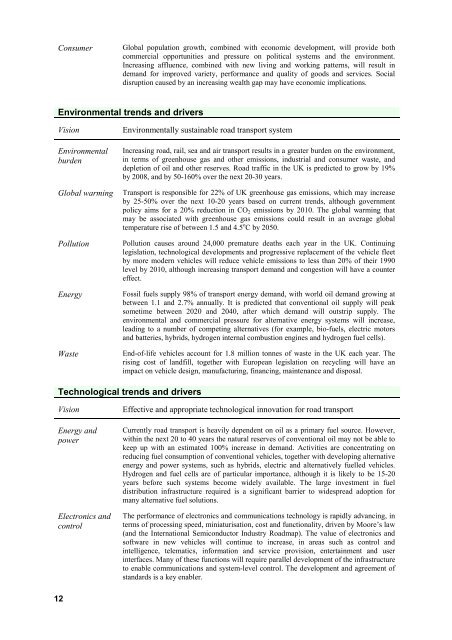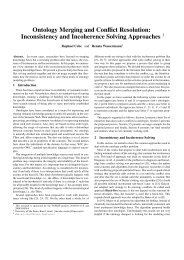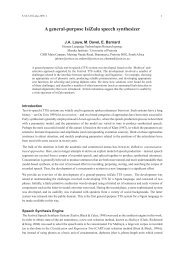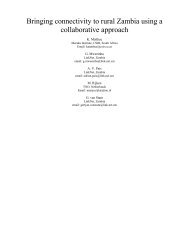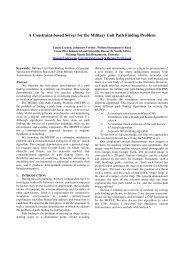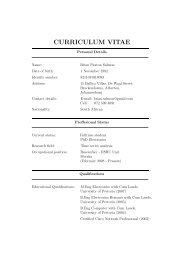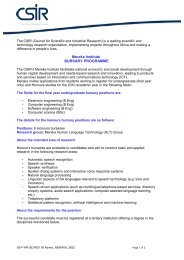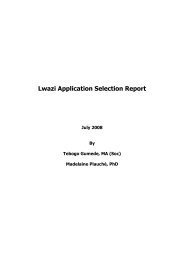Foresight Vehicle Technology Roadmap - Institute for Manufacturing
Foresight Vehicle Technology Roadmap - Institute for Manufacturing
Foresight Vehicle Technology Roadmap - Institute for Manufacturing
- No tags were found...
Create successful ePaper yourself
Turn your PDF publications into a flip-book with our unique Google optimized e-Paper software.
ConsumerGlobal population growth, combined with economic development, will provide bothcommercial opportunities and pressure on political systems and the environment.Increasing affluence, combined with new living and working patterns, will result indemand <strong>for</strong> improved variety, per<strong>for</strong>mance and quality of goods and services. Socialdisruption caused by an increasing wealth gap may have economic implications.Environmental trends and driversVisionEnvironmentalburdenGlobal warmingPollutionEnergyWasteEnvironmentally sustainable road transport systemIncreasing road, rail, sea and air transport results in a greater burden on the environment,in terms of greenhouse gas and other emissions, industrial and consumer waste, anddepletion of oil and other reserves. Road traffic in the UK is predicted to grow by 19%by 2008, and by 50-160% over the next 20-30 years.Transport is responsible <strong>for</strong> 22% of UK greenhouse gas emissions, which may increaseby 25-50% over the next 10-20 years based on current trends, although governmentpolicy aims <strong>for</strong> a 20% reduction in CO 2 emissions by 2010. The global warming thatmay be associated with greenhouse gas emissions could result in an average globaltemperature rise of between 1.5 and 4.5 o C by 2050.Pollution causes around 24,000 premature deaths each year in the UK. Continuinglegislation, technological developments and progressive replacement of the vehicle fleetby more modern vehicles will reduce vehicle emissions to less than 20% of their 1990level by 2010, although increasing transport demand and congestion will have a countereffect.Fossil fuels supply 98% of transport energy demand, with world oil demand growing atbetween 1.1 and 2.7% annually. It is predicted that conventional oil supply will peaksometime between 2020 and 2040, after which demand will outstrip supply. Theenvironmental and commercial pressure <strong>for</strong> alternative energy systems will increase,leading to a number of competing alternatives (<strong>for</strong> example, bio-fuels, electric motorsand batteries, hybrids, hydrogen internal combustion engines and hydrogen fuel cells).End-of-life vehicles account <strong>for</strong> 1.8 million tonnes of waste in the UK each year. Therising cost of landfill, together with European legislation on recycling will have animpact on vehicle design, manufacturing, financing, maintenance and disposal.Technological trends and driversVisionEnergy andpowerElectronics andcontrolEffective and appropriate technological innovation <strong>for</strong> road transportCurrently road transport is heavily dependent on oil as a primary fuel source. However,within the next 20 to 40 years the natural reserves of conventional oil may not be able tokeep up with an estimated 100% increase in demand. Activities are concentrating onreducing fuel consumption of conventional vehicles, together with developing alternativeenergy and power systems, such as hybrids, electric and alternatively fuelled vehicles.Hydrogen and fuel cells are of particular importance, although it is likely to be 15-20years be<strong>for</strong>e such systems become widely available. The large investment in fueldistribution infrastructure required is a significant barrier to widespread adoption <strong>for</strong>many alternative fuel solutions.The per<strong>for</strong>mance of electronics and communications technology is rapidly advancing, interms of processing speed, miniaturisation, cost and functionality, driven by Moore’s law(and the International Semiconductor Industry <strong>Roadmap</strong>). The value of electronics andsoftware in new vehicles will continue to increase, in areas such as control andintelligence, telematics, in<strong>for</strong>mation and service provision, entertainment and userinterfaces. Many of these functions will require parallel development of the infrastructureto enable communications and system-level control. The development and agreement ofstandards is a key enabler.12


